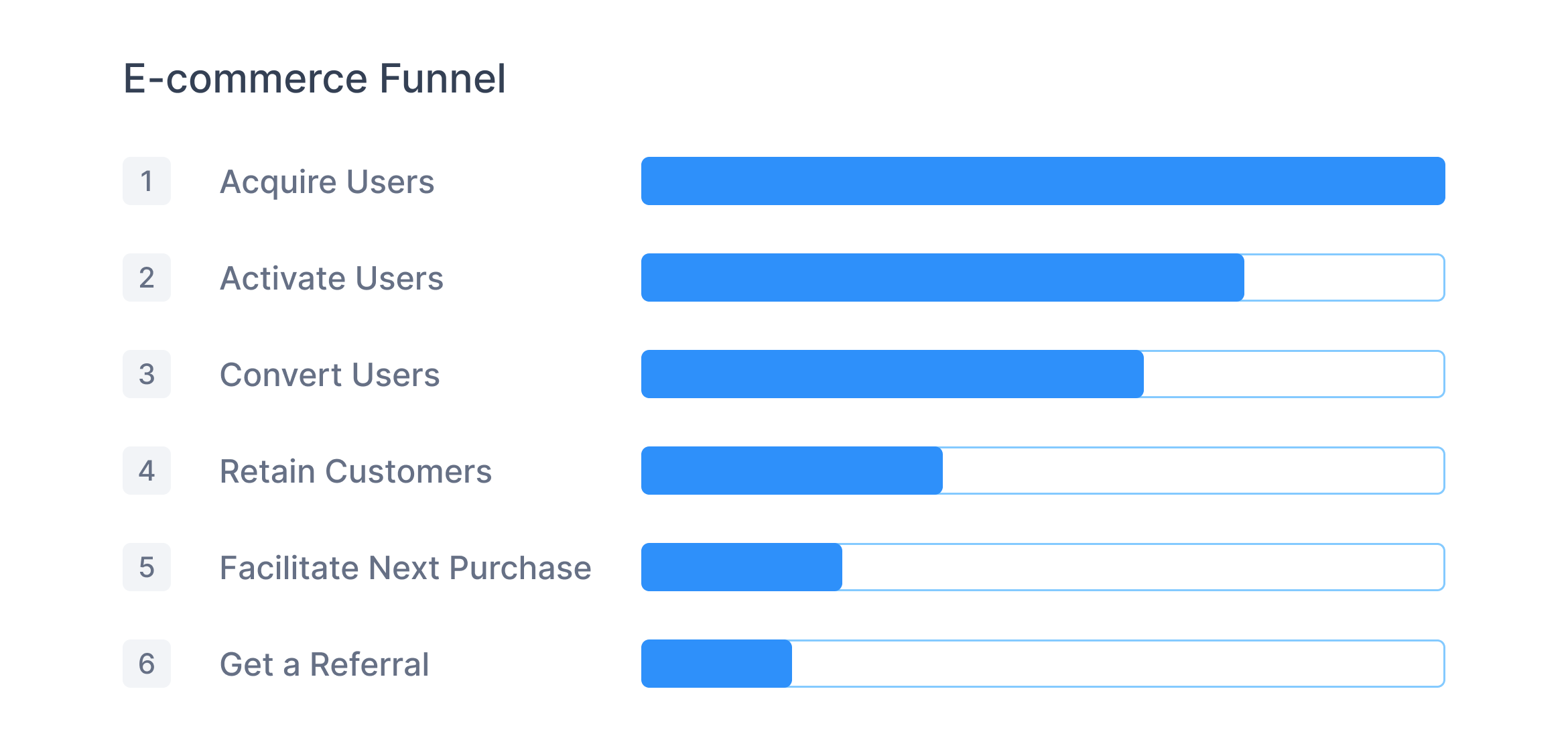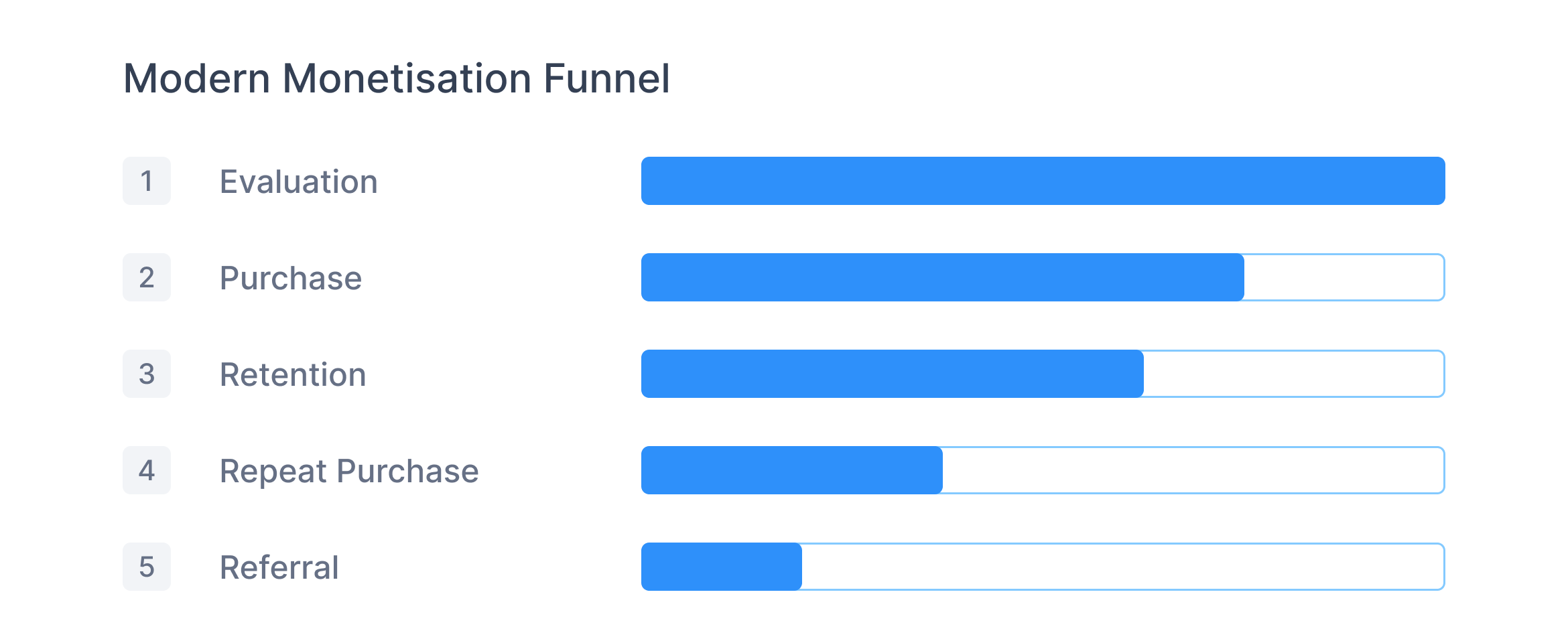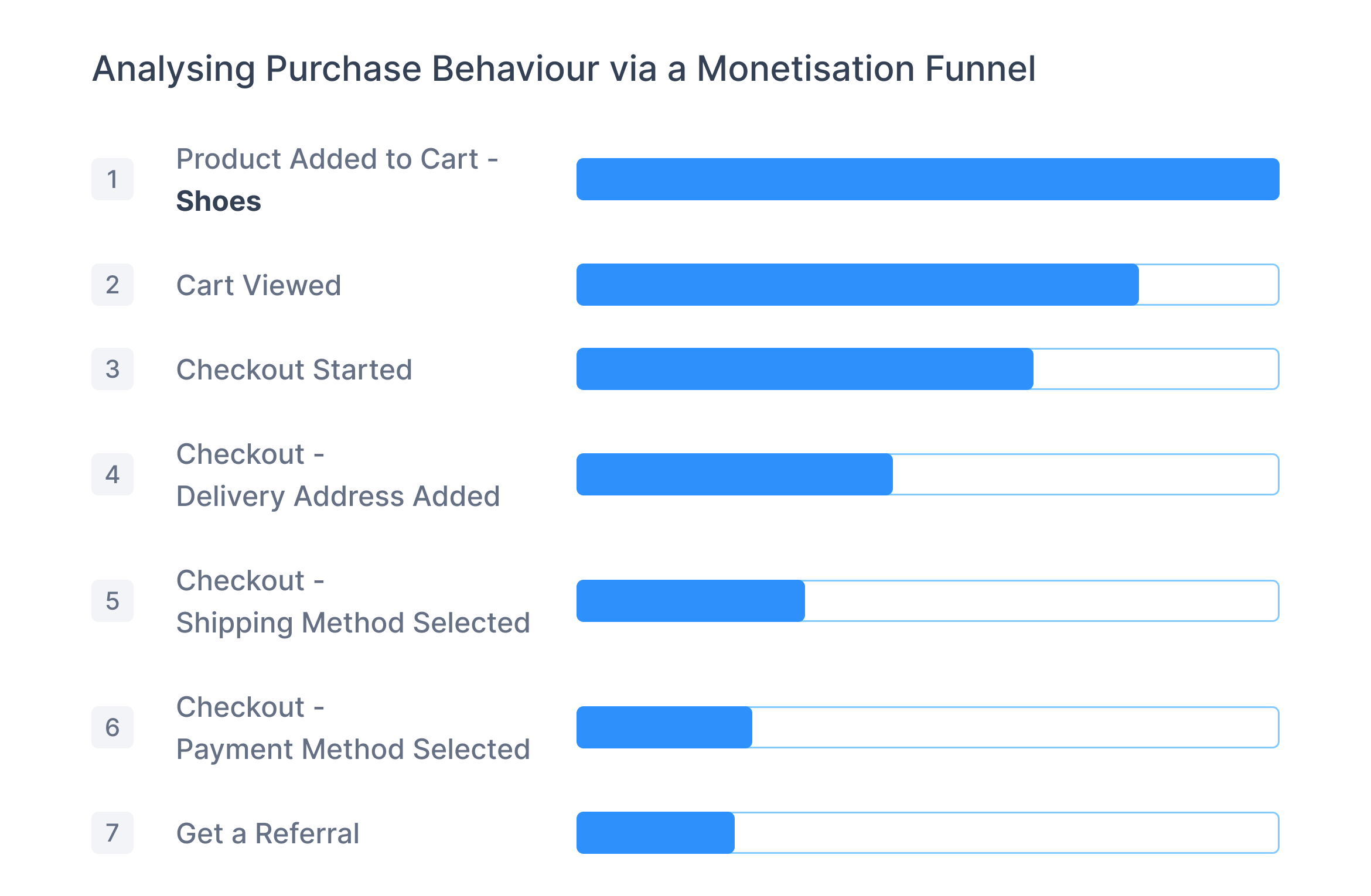Funnels
A beginner's guide to funnel analysis to understand user behavior across their lifecycle
What are Funnels?
In the context of online businesses, a funnel refers to the path a user can take through your website or mobile app to reach the end goal.
A path, or funnel, can either be as small as a single step or can comprise of several steps a user needs to perform, before reaching the end goal. However, funnels are not just restricted to a user’s movements through your website/app, but can also extend to capturing how they interact with your marketing campaigns.
But do all users, who enter a funnel, reach the end goal?
No. It’s safe to say that a majority of the users would drop-off at different stages of the funnel. Let's understand this better with a use-case.
Use-case: Tracking conversions for an e-commerce fashion site for womenLet's say that you have an e-commerce website that sells designer shoes exclusively for women. The end goal for a marketer, in this case, would be to drive up the sale of shoes. But to do so, one would have to ensure their brand’s growing visibility across different platforms, engage users in a manner which builds trust and eventually drives them to purchase.
So broadly, your plan would look something like this:

Click to enlarge
Sounds like a fair plan, right? This is exactly what a funnel looks like.
Hence, if you run an online business, you already have a funnel in place. The real challenge lies in understanding how you can remove the leaks in your funnel. This requires marketers to have an in-depth knowledge of user behaviour. While most marketers would want to fill in the funnel quickly with quantity, the right approach is to fill it in with quality leads.
Types of Funnels
Conversion, as a concept, is always about getting more value from the traffic you have, rather than generating more traffic. Keeping this in mind, the logical thing to do before optimizing overall conversion is to break the funnel above, into smaller funnels;
This allows you to clearly identify the areas where the problem lies. The problem could be in one of these funnels or in all three of the funnels. By identifying the problems at a granular level, you will know that you’re solving the right problems that will reduce your drop-off rate at each stage and increase your overall conversion.
Here’s a detailed explanation of how you can go about it:
1. Acquisition Funnel
The aim of an acquisition funnel is to bring in more prospects (leads) and customers to your website/app. A typical acquisition funnel looks like this:

Click to enlarge
Use-case: Optimizing funnel conversions post acquisitionLet’s say that you are running a Facebook campaign to acquire new customers for your e-commerce website which sells designer shoes exclusively for women.
In this case, your campaign will be targeted exclusively at women above 18 years of age, located within the geographical range within which you can deliver. You could go a step further and target women who may have shown interest in your competitors - making it more likely to acquire users with a high intent to purchase.
Once you have created awareness, it’s time to pique their interest with engaging content.
Solution
Here are a few ideas to increase conversions from this funnel to the activation funnel:
- Create landing pages, specifically designed to target a particular audience and answer possible questions they may have.
- Display customer reviews of your products/services on Google and popular review sites.
- Engage users with customer testimonials.
- Create engaging social media posts and re-target these users with paid campaigns.
2. Activation Funnel
The aim of an activation funnel is to convert a large number of prospects into customers. A typical activation funnel looks like this:

Click to enlarge
Users who enter your activation funnel are only a few steps away from making a purchase (converting). This is why, at this point, it is important for marketers to reassure them that their product is the best one out there. A few ideas which can help marketers push prospects through the activation funnel are:
- Product demo videos
- Blog posts with in-depth knowledge
- Customer testimonials
If shown at the right stage and at the right time to each user, such content can help drive the conversion rates a great deal.
Use-case: Optimizing funnel conversions post activationLet’s say you run a financial services website which helps people plan their investments. You have acquired a large number of users through organic search traffic as a result of an engaging blog post. The users have signed up for your services but have not started using your product/services yet.
Solution
To push users to the second step of the acquisition funnel, Intent, you could email them newsletters periodically, with links to informative blogs posts and case studies talking about how your customers made millions by investing their money smartly.
The idea is to show these newly acquired users the value proposition of your product/services and build trust in your advice by exhibiting how others have benefited from it.
3. Monetization Funnel
A traditional monetisation funnel aims at converting users into customers by driving them to make their first purchase, and it looks something like this:

Click to enlarge
But sadly, this funnel ends with Purchase - missing out on the massive opportunity of retaining these customers through post-purchase engagement.
Which, do you think is a more effective approach?
-
Investing solely in engaging potential customers to make a purchase, pushing them through several stages of your funnel.
-
Investing in converting new users and engaging existing customers, pushing them just through the monetisation funnel.
It's definitely the latter.
Retention marketing is not just easier, but also cheaper than acquiring new users.
Easier, because you have already established a relationship with your customers, which if nurtured with the right approach, can help you cultivate brand loyalty.
Cheaper, because nurturing an existing relationship requires less effort and resources than creating a new one.
Hence, the modern monetisation funnel focusses on the pre-purchase and the post-purchase journey of a user, keeping them in the loop long after their first transaction. It looks something like this:

Click to enlarge
Let's quickly go over the post-purchase stages to help you understand how they fit into your overall marketing efforts.
Retention
Customer retention is the ability of a business to keep their customers engaged through valuable interactions which cultivate brand loyalty and drive growth.
Retention marketing broadly revolves around understanding the needs of your customers and engaging them accordingly, with the end goal of creating a sense of trust. A few strategies which help drive customer retention include;
- Periodically engaging customers with related products, highlights of new releases/ collections.
- Asking them for a review and rating on a public platform, or built it into your product.
- Enrolling customers in a loyalty reward program.
- Educating customers about the product or service and how they can make the most of it.
And so on.
Repeat Purchase
Most customers who organically come back to your business do so because they simply loved the experience the first time! But such customers make up for less than 30% of the customers acquired by you. Hence, post-purchase engagement plays a significant role in driving repeat purchases, compounding the value of a retained customer manifold in a short span of time.
Referral
Approach to Creating Funnels
A funnel is like a water filtration system. It has several stages, each aimed at pushing the inflow of users towards making a monetary transaction. But just like a water filtration system filters out all the gunk - not all the users who enter your funnel, come out at the end. The difference being, a water filtration system is designed to filter out the gunk, but an ideal funnel is one where a majority of the users exit it.
Achieving a 0% drop-off rate in a funnel is practically impossible. But by actively reducing the drop-off at each stage, you can optimise the funnel for high conversions.
Here's a step-by-step guide to creating and analysing funnels for maximum impact:
Step 1: Identify the end goal, which could be anything depending on your business. A few examples include signup, purchase, add to cart, subscription renewal and so on.
Step 2: Define all the paths a user can take to reach the end goal when interacting with your app, website and marketing campaigns.
Step 3: Identify all the events a user needs to perform in each path, to reach the end goal.
Each path identified in Step 2 represents a funnel and each event defined in Step 3 represents a step in a funnel. So, now you have a list of funnels which you can create, save and analyse them over a period to understand your users' behaviour.
Step 4: Analyse each funnel to understand parameters like; overall conversion rate, the average time taken to convert, drop-off rate between each step and so on.
Step 5: Create a hypothesis around the possible reasons for the high drop-off rate, conversion time etc. and take relevant actions to optimise the funnel.
Hence, funnel analysis needs to be an ongoing exercise to increase your conversion rates. Changing the layout and messaging of your app, website and campaigns is easier than changing the behaviour of your target audience. In a highly-competitive industry, listening to your users and understanding their behaviour is what will help set you apart.
Use-case: Optimizing a monetization funnelLet’s say that a user shortlists a pair of shoes on your site by adding it to their cart, but hasn't purchased it yet. Such users are essentially lying at the top of the monetisation funnel and need some assurance or motivation to convert.
Here's what the funnel will look like in this case:

Click to enlarge
So, if a user drops off before hitting the Checkout Complete button, then by analysing the statistics of this funnel, you will know which step has the highest drop-off rate. This information is critical in identifying possible reasons for cart abandonment and creating a personalised message, urging them to complete the checkout process.
Continuation of the use-case: Optimizing a monetization funnelFor example, you notice a high drop off rate between the steps; Payment Method Selected and Checkout Complete. On digging deeper, you could come across a situation wherein the drop-off rate is higher for users who selected Online Payment as their preferred mode of payment, compared to those who opted for Cash on Delivery (COD).
A few possible reasons for this could be:
The link to your online payment merchant is broken.
The user’s bank’s online transaction page isn’t working.
There was a connectivity error which led to an unsuccessful transaction.
Solution
Engage these users with a message that provides alternatives like:
- Payment on delivery
- Delayed online payment, which could be made anytime before delivery
- Link to another payment gateway
We hope this has warmed you up well to how funnel analysis can help you optimize user engagement and conversion rates.
Updated 19 days ago
Let's show you how to create, analyze and modify funnels in your dashboard: